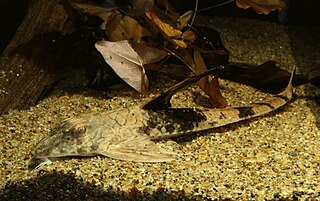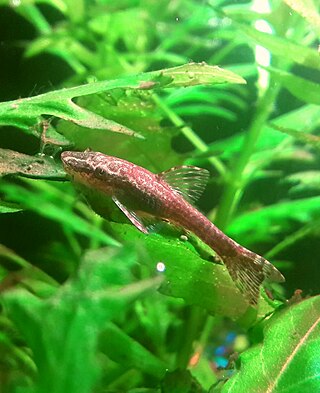
Loricariidae is the largest family of catfish, with over 90 genera and just over 680 species. Loricariids originate from freshwater habitats of Costa Rica, Panama, and tropical and subtropical South America. These fish are noted for the bony plates covering their bodies and their suckermouths. Several genera are sold as "plecos", notably the suckermouth catfish, Hypostomus plecostomus, and are popular as aquarium fish.

Hypostomus is a genus of catfish in the family Loricariidae. They are native to tropical and subtropical South America. H. plecostomus is the popular freshwater aquarium fish formerly known as Plecostomus plecostomus. The taxonomic structure of the Loricariidae is still being expanded by scientists. Hypostomus is a highly species-rich and widely distributed catfish genus.

Otocinclus is a genus of catfish in the family Loricariidae native to South America, commonly known as "dwarf suckers" or "otos". This genus, like other loricariids, is characterized by rows of armour plating covering the body, as well as the underslung suckermouth. They are generally small in size; O. tapirape is the smallest of the species (2.4 cm), while O. flexilis is the biggest (5.5 cm). These species have adaptations that allow them to breathe air. A duct forms at the junction between the esophagus and the stomach and expands into an enlarged, ring-like diverticulum, characteristic of this genus, which allows air-breathing. Otocinclus are popular aquarium fish, and they are often purchased as algae eaters. It is difficult to breed them in captivity, and only wild caught Otocinclus are available to hobbyists. This genus is widely distributed east of the Andes of South America, throughout the lowlands from northern Venezuela to northern Argentina, but are generally absent from the Amazon and the Orinoco lowlands.

Aspidoras is a genus of catfishes of the family Callichthyidae from Brazil.

Rineloricaria is a genus of freshwater tropical catfish belonging to the family Loricariidae. They are commonly called whiptail catfish because of the long filament that grows out of the tip of the caudal fin that is characteristic of the genus. With the exception of R. altipinnis from Panama, they are native to the rivers of northern and central South America. Some species are regularly seen in the aquarium trade.

Otothyropsis is a genus of armored catfishes native to South America.

The Hypoptopomatinae are a subfamily of catfishes of the family Loricariidae, composed of 17 genera and approximately 80 species. This subfamily represents about one-tenth of all loricariid species.
Hisonotus is a genus of armored catfishes native to South America. Species of Hisonotus and Curculionichthys are the only representatives of the subfamily Otothyrinae having serrae on the posterior edge of the pectoral fin spine. These species are small fishes, generally found in small fast flowing streams, where they grasp to the branches and leaves of aquatic or subaquatic plants. The species of this genus mostly occur in Atlantic coastal streams of southern Brazil and the Paraguay-Paraná system of southern South America. They are also distributed in the Río de La Plata basin and coastal rivers of southeastern Brazil.
Microlepidogaster is a genus of armored catfishes native to South America.
Harttia is a genus of armored catfishes native to South America.
Neoplecostominae is a subfamily of South American catfishes of the family Loricariidae. Species of this subfamily live in high-mountain and swift-flowing river habitats.

Parotocinclus is a genus of fish in the family Loricariidae native to South America. This genus is distributed through almost all hydrographic systems in South America from the Guyana Shield drainages and Amazon Shield tributaries to the coastal drainages of eastern and southeastern Brazil, including the rio São Francisco basin. Most species have the caudal peduncle oval in cross section. It has been found that Characidium species may interact with P. maculicauda. The small Characidium will follow grazing P. maculicauda, which release particulate matter dislodged from the catfish's foraging.
Neoplecostomus is a genus of fish in the family Loricariidae native to South America. Neoplecostomus can be distinguished from all other loricariids by a modified shield of small plates on the abdomen with posteriorly directed odontodes; the shield appears to act as a holdfast. The color pattern is generally mottled brown with the abdomen white. The head is long, rounded, and shovel-shaped. The fin spines are weak. They range from about 8 to 11 cm (3.1–4.3 in) SL. The species of Neoplecostomus live in fast-flowing water.
Pareiorhina is a genus of armored catfishes native to South America where they are only found in Brazil. These species are known to occur at altitudes above 650 metres (2100 ft) in various rivers of the Grande, Paraíba do Sul, São Francisco and Tietê River basins. This genus was first erected by Gosline in 1947 as a monotypic genus to include Rhinelepis rudolphi. It was not until 2003 that a second species, P. carrancas, was described. The third species, P. brachyrhyncha was described in 2005. Pareiorhina forms a monophyletic subunit with Neoplecostomus within the subfamily Neoplecostominae.
Isbrueckerichthys is a genus of armored catfishes which are endemic to Brazil.
Hypostomus agna is a species of catfish in the family Loricariidae. It is native to South America, where it occurs in the Ribeira de Iguape River basin. It was formally described as a new species in 1907 by Brazilian ichthyologist Alípio de Miranda-Ribeiro, as a species of Plecostomus.
Pareiorhaphis lophia is a species of catfish in the family Loricariidae. It is native to South America, where it occurs in the Paraguaçu River basin in Brazil. It is typically found in shallow rocky stretches of coastal blackwater rivers, including rapids. It is known to be syntopic with Hypostomus chrysostiktos and Hypostomus jaguar. The species reaches 8.2 cm in standard length and is believed to be a facultative air-breather.
Pareiorhaphis nasuta is a species of catfish in the family Loricariidae. It is native to South America, where it occurs in the Doce River basin in the state of Minas Gerais in Brazil. The type locality of the species is a small, shallow river with clear water, slow to moderate current, and a rocky substrate. It is also found in rapids, with larger individuals of the species occurring in faster-flowing areas. The species reaches 9.5 cm in standard length, is known to be sexually dimorphic, and is believed to be a facultative air-breather.
Pareiorhaphis parmula is a species of catfish in the family Loricariidae. It is native to South America, where it occurs in the Iguazu River basin in Brazil, with its type locality being given as the Dos Patos River in the state of Paraná. The species reaches at least 9.45 cm in standard length and is believed to be a facultative air-breather.
Pareiorhaphis vetula is a species of catfish in the family Loricariidae. It is native to South America, where it occurs in the headwaters of the Doce River basin in the state of Minas Gerais in Brazil. The species reaches at least 4.9 cm in standard length. It was described in 2016 by Edson H. L. Pereira, Pablo Lehmann A., and Roberto Esser dos Reis. FishBase does not yet list this species.







